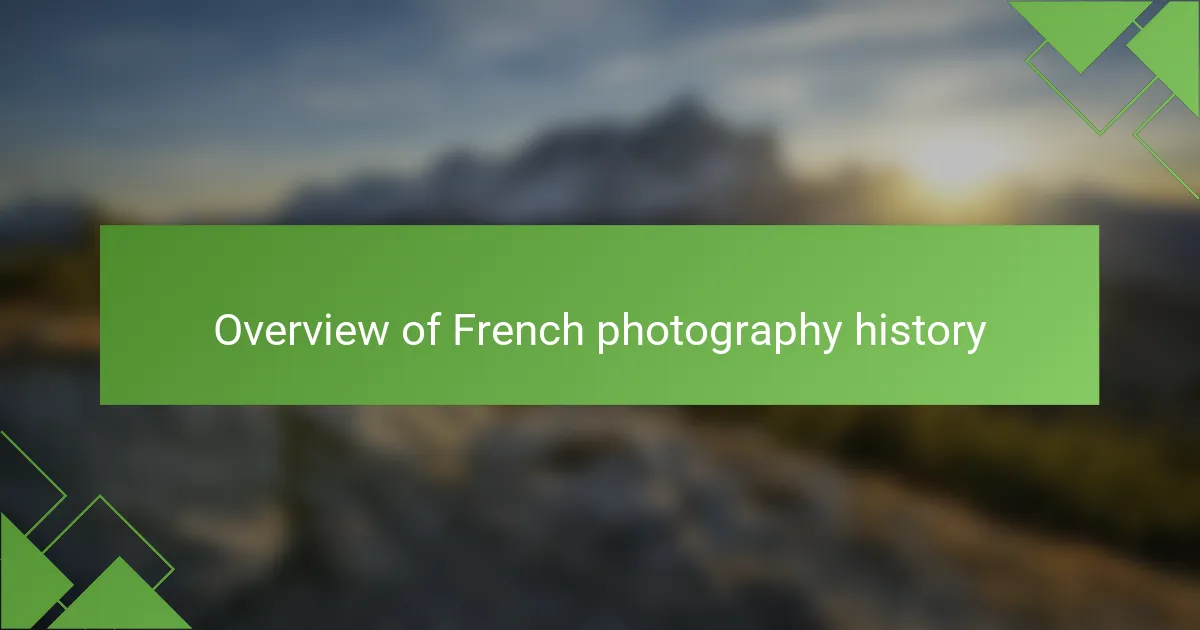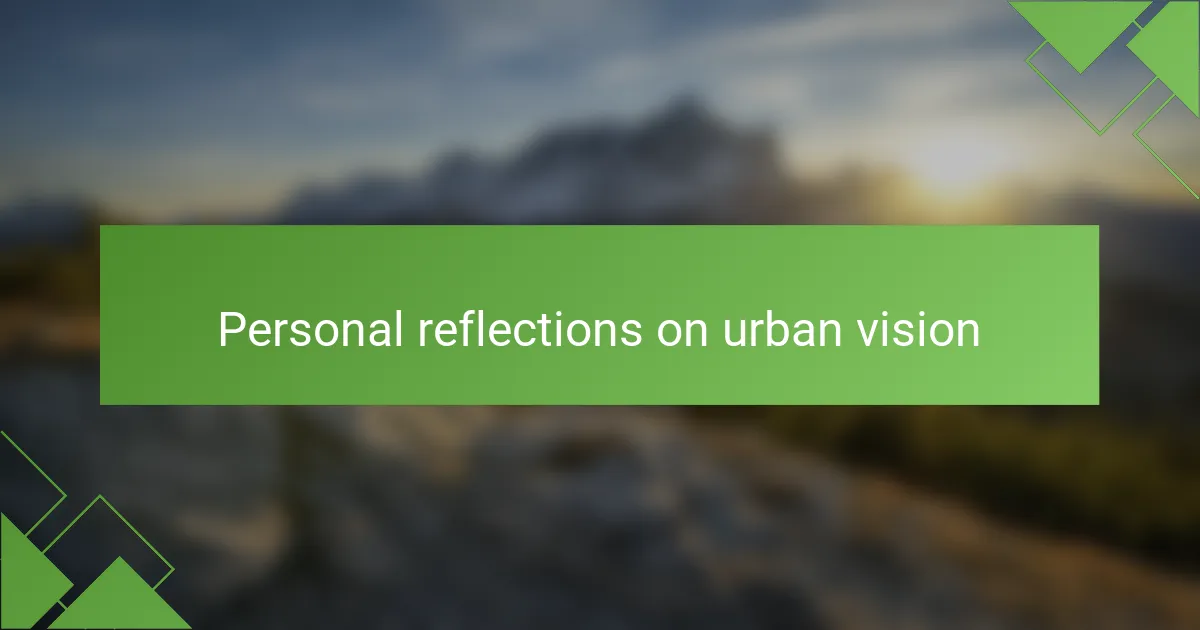Key takeaways
- Brassaï’s photography masterfully captures the soul of Paris at night, blending the ordinary with the extraordinary through high-contrast black-and-white images.
- His candid street photography approach evokes empathy and connection, encouraging viewers to notice hidden stories in everyday life.
- Brassaï’s influence is evident in modern urban photography, with artists embracing themes of light, shadow, and storytelling derived from his techniques.
- He emphasizes spontaneity, the emotional impact of light, and the significance of composition, inspiring photographers to seek out and share unseen narratives.

Understanding Brassaï’s photography style
Brassaï’s photography style is captivating for how adeptly he captures the soul of Paris at night. I often find myself lost in his images, which reveal shadows and light in an almost poetic dance. Have you ever looked at a photograph and felt as though you were stepping into another world? That’s the power Brassaï harnesses—mixing the eerie with the enchanting.
His choice to use high-contrast black-and-white images adds a dramatic flair that pulls viewers into a place of intense emotion and nostalgia. I can remember the first time I saw his work; it struck me how he could make mundane scenes feel both mysterious and intimate. How does he do it? Brassaï had this incredible ability to highlight the beauty in the overlooked aspects of urban life, making even simple street corners feel alive.
Another hallmark of his style is his candid approach to street photography. I admire how he didn’t stage his subjects but rather captured them in their natural environment. This authenticity creates a connection with the viewer, provoking a sense of empathy. It makes me wonder—how many stories are hidden in the fleeting moments of our everyday lives? Brassaï inspires us to notice the extraordinary within the ordinary.

Overview of French photography history
French photography has a rich and transformative history that shaped not only the art form itself but also how we perceive the world around us. From the early daguerreotypes of the 19th century that captured the essence of Parisian life to the candid street photography emerging in the latter part of the century, each wave of innovation pushed boundaries. I often find it fascinating to consider how these early pioneers laid the groundwork for the evocative storytelling seen in contemporary photography.
As I dive deeper into the movements that evolved alongside the art, I can’t help but feel a sense of connection to photographers like Henri Cartier-Bresson. His approach reshaped the concept of the “decisive moment,” urging photographers to embrace spontaneity and capture life as it unfolds. Have you ever experienced that rush when you snap a photo just at the right time? It’s exhilarating, and I wonder if that sense of timing connects back to those foundational moments in French photography’s history.
The 20th century brought about even more experimentation and expression, with surrealism and modernist influences steeping the medium in a tapestry of new ideas. I’ve often thought about how this dynamic evolution reflects the spirit of France itself—a country forever in a state of artistic reinvention. How does one pinpoint the exact moment in which a culture shifts, especially in the realm of photography? For me, it’s evident in the way these historical movements challenge our perceptions and encourage us to see life through a more imaginative lens.

Key attributes of urban photography
Urban photography captures the essence of a city’s life, reflecting its vibrancy and complexities. One key attribute is the ability to encapsulate fleeting moments within the hustle and bustle. For instance, I remember while wandering the streets of Paris, I stumbled upon a street performer lost in his music, surrounded by a sea of busy pedestrians. That moment reminded me how urban photography can reveal stories hidden in the chaos.
Another essential aspect is the play of light and shadow. Brassaï had an extraordinary talent for using nighttime light to transform ordinary scenes into something magical. I often find that the contrast between bright neon signs and dark alleys in urban settings can evoke a sense of mystery and intrigue that invites the viewer to explore deeper.
Lastly, composition is crucial in urban photography. The way elements are arranged within a frame can significantly alter the message conveyed. I recall capturing a simple brick wall adorned with graffiti; the vibrant colors and textures told a story of resilience and expression that words simply couldn’t capture.
| Key Attribute | Description |
|---|---|
| Capturing Fleeting Moments | Reflects the vibrancy of city life and reveals hidden stories. |
| Play of Light and Shadow | Transforms ordinary scenes into something extraordinary, creating intrigue. |
| Effective Composition | Arranges elements to enhance storytelling through visual imagery. |

Notable works by Brassaï
Brassaï’s most notable series, “Paris de Nuit,” stands out as a testament to his talent. Capturing the city after dark, each photograph immerses viewers in a nocturnal wonderland. I remember the first image I saw from this series, a shadow-filled street corner that felt alive yet haunting, provoking a flood of emotions. How did he manage to encapsulate both vibrancy and solitude in one frame?
One of his iconic works, “The Lovers,” showcases his remarkable ability to capture intimate moments amidst the urban chaos. I find myself transfixed by the raw emotion displayed between the couple against the backdrop of a bustling Parisian street. It’s moments like these that make you question what hidden stories unfold in our daily lives. What if our greatest stories are waiting just beyond the lens, unnoticed?
In another powerful piece, “Graffiti,” Brassaï immortalized the urban art that decorated the lesser-known corners of Paris. His lens transformed graffiti into sublime street art, elevating it beyond mere vandalism. I can’t help but reflect on how his work challenged societal perceptions, inviting us to appreciate urban expressions often overlooked. Isn’t it fascinating how a single photograph can shift our understanding of a city and its culture?

Personal reflections on urban vision
Brassai’s urban vision captivates me deeply. His ability to transform the ordinary into the extraordinary resonates with my own appreciation for the overlooked details of city life. I recall wandering through Paris at night, much like he did, feeling that palpable magic—the way light reflects off wet cobblestones, or how a single streetlamp can cast shadows that dance across a quiet alley.
There’s a raw honesty in Brassai’s work that strikes a chord with my perspective on urban environments. His exploration of nightlife through photography reminds me of the moments I’ve spent at local cafés, not just sipping coffee, but absorbing the tales told by strangers around me. It’s as if he captured not just images, but the very essence of human experience in an urban backdrop.
Comparing his approach to modern urban photography is fascinating. It shows how far we’ve come while also highlighting timeless themes that still resonate today.
| Aspect | Brassai’s Urban Vision | Modern Urban Photography |
|---|---|---|
| Subject Matter | Nightlife, isolation, and intimacy | Spectrum of urban life, from landscapes to portraits |
| Techniques | Black and white, raw, emotional capture | Digital, varied styles and editing methods |
| Emotional Impact | Evokes nostalgia and connection | Reflects modern issues and diversity |

Lessons from Brassaï’s techniques
Brassaï taught me the importance of spontaneity in photography. I remember the thrill of capturing a moment without staging it, much like he did with his candid street scenes. Have you ever felt that rush when you snap a photo just before the perfect moment slips away? That’s the essence of his technique—it’s all about being ready to seize the unexpected magic that unfolds in front of you.
One significant lesson I’ve learned from Brassaï is the power of light. His use of nighttime illumination transformed ordinary streets into stunning visual narratives. I often think about how a single streetlamp can change the whole mood of an environment. It makes me wonder, how does light interact with our emotions when we encounter a scene? Brassaï demonstrated that light is not just a means of seeing; it’s a dynamic force that evokes feelings and enhances stories.
Lastly, I discovered that composition is not merely about arrangement; it’s about storytelling. Brassaï’s framing of subjects told narratives that resonated with my own experiences in urban spaces. I once captured a photograph of a city worker against the backdrop of bustling streets, and I realized how the composition echoed the unseen stories of everyday lives. Isn’t it fascinating how a thoughtfully composed image can make you pause and reflect on the hidden narratives around us? Brassaï’s work encourages us all to seek those stories through our lenses.

Impact of Brassaï’s art today
Brassaï’s urban vision continues to resonate in today’s photography landscape, influencing a new generation of artists who seek to capture the essence of city life. His ability to find beauty in the mundane forces us to reconsider our own urban experiences. I remember walking through the streets of Paris, feeling his spirit in the atmospheric shadows and the vibrant stories whispered by the walls.
Moreover, contemporary photographers often echo Brassaï’s focus on the interplay between light and shadow. This technique not only enhances the emotional depth of the image but also invites viewers to engage actively with the scene, much like Brassaï’s own work did. Reflecting on how his artistry sheds light on unseen narratives is both inspiring and humbling.
Here’s a comparison table highlighting Brassaï’s influence on today’s photography:
| Aspect | Brassaï’s Approach | Modern Photography |
|---|---|---|
| Urban Aesthetics | Focus on the beauty of urban life | Continuing exploration of city landscapes |
| Light and Shadow | Mastery of contrasts | Emphasis on mood and atmosphere |
| Storytelling | Captures hidden narratives | Encourages emotional connections with viewers |